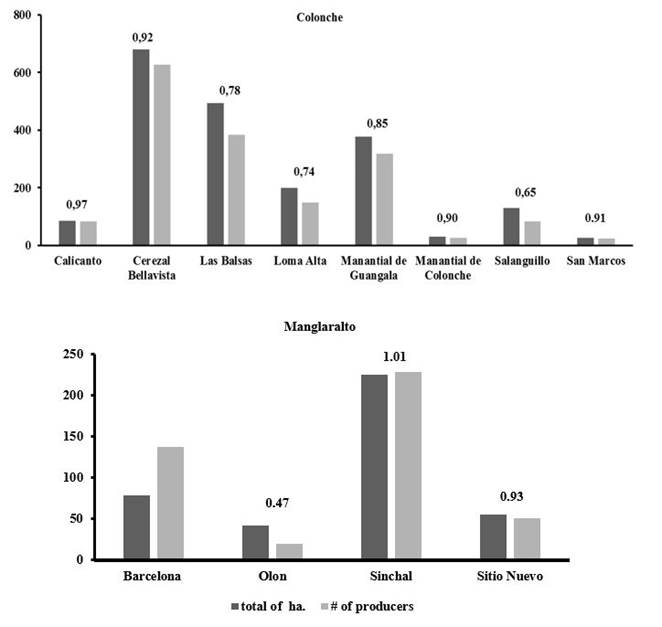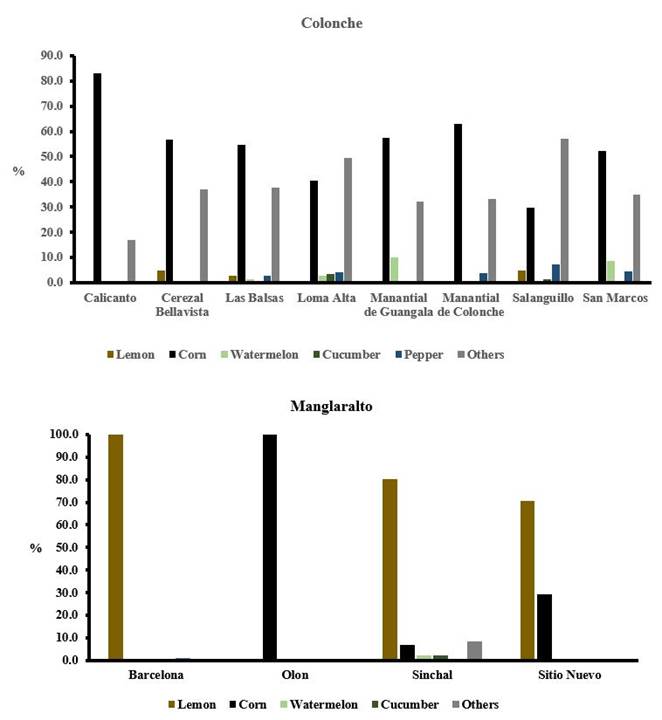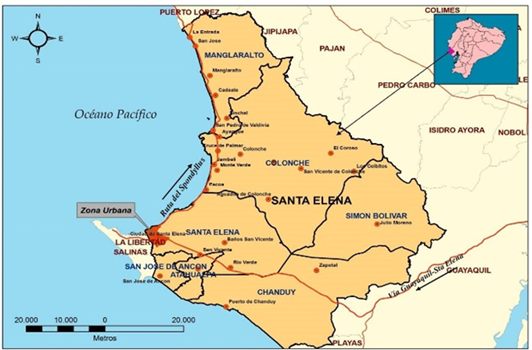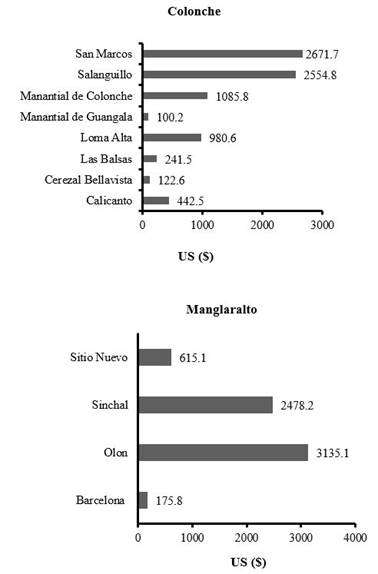Mi SciELO
Servicios Personalizados
Revista
Articulo
Indicadores
-
 Citado por SciELO
Citado por SciELO
Links relacionados
-
 Similares en
SciELO
Similares en
SciELO
Compartir
Cultivos Tropicales
versión impresa ISSN 0258-5936versión On-line ISSN 1819-4087
cultrop vol.42 no.4 La Habana oct.-dic. 2021 Epub 30-Dic-2021
Original article
Agricultural production systems in the northern parishes of Santa Elena province, Ecuador
1Universidad Estatal de la Península de Santa Elena (UPSE), Facultad de Ciencias Agrarias. Santa Elena, Ecuador. Vía La Libertad, Santa Elena, Ecuador
2Universidad Agraria de La Habana “Fructuoso Rodríguez Pérez” (UNAH), carretera a Tapaste y Autopista Nacional, San José de las Lajas, Mayabeque, Cuba, CP 32 700
In this work, a characterization of the existing agricultural production systems in the parishes of Manglaralto and Colonche in Santa Elena province, Ecuador, was carried out in the period 2011-2016. This was carried out with the purpose of assessing the agro-productive development of the same and its possibility for an agroecological transition, as a result of the implementation of the Comprehensive Project for Sustainable Agricultural, Environmental and Social Development in Ecuador (PIDAASSE according its acronyms in Spanish) approved and implemented since 2009. The study was carried out with communes of two localities, covering a population of 2131 producers, from whom information related to technical and socioeconomic aspects of the farms was processed. The data were processed through the SPSS Statistical Package version 19.0, obtaining as main results that most farmers have difficulties for irrigation, low income and monoculture as the main production option, so there is little biodiversity, being the Manglaralto parish the most disadvantaged. Results show the need for a change in production strategies that prioritize actions for the use of agroecological practices, the inclusion of women and more training, as they have a low level of education, leading to a successful agroecological transition.
Key words: communes; diagnosis; agroecosystems
INTRODUCTION
The deterioration and fragmentation of ecosystems and the consequent biodiversity loss constitute one of the most serious problems facing humanity. The relationship between man and natural resources is erroneously contradictory, since societies grow and develop at the expense of their natural resources while at the same time destroying them at an alarming rate 1. For this reason, the agroecological conversion of conventional agricultural production systems is being considered by public agencies that maintain the competence, both budgetary and operational, to transfer aid and knowledge to producers, for the conservation of ecosystems.
In this sense, the Ecuadorian Constitution indicates agroecology as one of the elements on which production should be based, promoting the conservation of natural resources and the environment 2. Agroecology is not only a science and practice in the field, but also a social and political movement that seeks to transform the corporate food model through research, implementation and defense of socially just, economically equitable and ecologically resilient models 1.
The Ecuadorian government has been provisional in the criterion that the possibility of planning economic and social development at the regional level is based on watersheds, which constitute planning units for the management of water and agricultural resources, as well as the location of populations for objective land use planning. This becomes even more important when it is noted that Santa Elena is characterized as a dry region with low rainfall 3.
One of the methodological challenges of studying and monitoring the agroecological transition in a given region is to characterize both the starting point and the different stages of the transition 4. Therefore, the main objective of this work is to characterize the existing agricultural systems in Manglaralto and Colonche communes, through productive, economic and social indicators, in order to assess the current agro-productive development of these parishes and their potential for an agroecological transition, following the implementation of the Comprehensive Project for Sustainable Agricultural, Environmental and Social Development in Ecuador (PIDAASSE) approved and implemented since 2009.
MATERIALS AND METHODS
In this work we studied Manglaralto and Colonche parishes, which are mainly dedicated to food production. Because of their natural and productive qualities, they have been chosen by for-profit and non-profit organizations as an opportunity to test development patterns, some successful and others with weaknesses 5, also taking into account the primary information provided by the general diagnosis carried out by the Ministry of Agriculture in 2009, which executed the Comprehensive Project for Sustainable Agricultural, Environmental and Social Development in Ecuador (PIDAASSE) 6.
Santa Elena province is located in the southwestern part of Ecuador's territory, on the south Pacific coastline, with a tropical climate and an area of 3,762.8 km2 divided politically into three cantons: Santa Elena, La Libertad and Salinas (Figure 1). Its productive areas include fishing, industry, agriculture, livestock, tourism, among other activities that boost trade and the local and national economy.
Santa Elena canton is the largest and it is the province capital of the same name, where 308,693 people live, according to the last national census conducted in 2010 7 and does not have reliable water sources during long periods of low rainfall, which significantly affects economic activities of agriculture and ecotourism that take place in the area. It is made up of Santa Elena (periphery), Ancón, Atahualpa, Colonche, Chanduy, Manglaralto and Simón Bolívar parishes.
A characteristic of Santa Elena canton is that in addition to its political-administrative division, it has a territorial division by communes, within which decisions are made autonomously, according to the Law of Organization and Regime of Communes, approved since 2004 and which are legally registered, recognized and administratively depend on the Ministry of Agriculture, Livestock and Fisheries. They also concentrate their efforts of institutional cooperation, through the national government with other public service agencies and are considered organized groups of collective law with their own forms of coexistence and development 8.
A characterization of the existing situation was carried out for a population of 2131 producers, owners and partners of farms, from the productive, economic and social point of view, where the specific variables were: the number of producers and their relationship with farm size (ha) in production, crops produced and the average annual income obtained from sales; in addition, for the social aspects related to educational level, sex and average age, a representative sample was taken of 73 % of Colonche and 94 % of Manglaralto. The statistical processing of the information of all variables was carried out using the SPSS Statistical Package in its version 19.0 of 2010.
RESULTS AND DISCUSSION
Figure 2 shows the relationship between the total ha-1 and the number of producers in both parishes. It is evident that in Colonche parish there is a greater area with respect to the number of producers, since it has favorable conditions for this. This may be due to the availability of natural and artificial water, which is the essential basis for high and stable production, according to the existing soil and climatic conditions that influence agriculture 9, which is more evident in the Cerezal Bellavista, Las Balsas, Loma Alta and Manantial de Guangala communities.
Similar behavior occurs in Sinchal and Barcelona of Manglaralto parish, since according to previous studies, water availability was the fundamental condition for the development of agricultural, forestry and social programs, given that this area is located in the dry region of the Ecuadorian coast 6.

Figure 2 Total (ha-1) of farms and proportion of producers in the Colonche and Manglaralto municipalities
The edaphoclimatic characteristics of the northern part of Santa Elena province cause a marked difference in the sowing, planting and development of crops in the different parishes that make up the province. In addition, there is Chongón-Colonche Protected Forest, which occupies a little more than 40 % of the territory and directly influences the conditions for sustainable agricultural production 3.
According to existing data, the agricultural area of Colonche parish is 1137.2 km2 and Manglaralto is 497.4 km2 (7. This means that the total number of farmers dedicated to agricultural production varies. However, there are no differences between them in terms of the amount of land in production, which on average ranges between 0.5 and 1.7 ha-1 per producer, even though the right of possession granted by the commune allows them to have more, which may or may not be cultivated 10.
Figure 3 shows the relative number of producers (%) in each of the existing crops in the two parishes under study. In general, there is little diversification, with corn predominating in Colonche and lemons in Manglaralto as the main crops on which family agriculture depends.

Figure 3 Relative number of producers (%) by crops in production distributed by communes in the parishes under study
It is evident that in Colonche only a minimum of producers (12.4 %) are dedicated to lemon cultivation in Salanguillo, Las Balsas and Cerezal Bellavista, while in Manglaralto communes all grow it except those of Olón. In Barcelona, 100 % of them, since the latter is close to the Valdivia-California river basin and its phreatic level allows citrus cultivation to have better irrigation conditions through the river itself or water from deep wells. This has allowed it to be a production option for many years in this sector; however, it has several problems related to technology that lead to low yields 11. The Olón commune is in the same condition in terms of corn production, which benefits from the Olón river basin and the rainfall that favors it during most of the year 9.
In Colonche parish, a greater number of producers are dedicated to other crop production such as watermelon, cucumber, pepper, melon, onion, coffee, cocoa and passion fruit, while in Manglaralto this is not the case. In Sinchal commune, other crops are grown, mainly melon and onion, but without the widespread use of agroecological practices and intercropping, since only crop rotation with high dependence on water is carried out, despite the fact that there have been experiences with training and advice to producers and the provision of resources for irrigation 6,12.
These aspects are important for the agroecological transition, which always begins at the productive farm scale with a change in management practices, although ideally it should begin with the agroecosystem redesign 4. This lack of diversification causes negative externalities; on the other hand, sustainable agroecologically based systems integrate a diversity of crop, animal and tree species, through complex designs, in fields of different dimensions, to favor multi-functions that reduce degrading practices and external inputs, as well as increase ecological services 13-15, which is necessary in this zone, if a future strategy is to achieve sustainability in the existing agroecosystems in both parishes, just as they are needed; In addition, reforms in policies, institutions and research and development programs are needed to ensure that these agroecological alternatives are transferred in a massive, equitable and accessible manner, so that their benefits are directed towards food security 16.
Figure 4 shows the average monthly income obtained by producers with the different crops harvested during the period under study.
Values of the average monthly income reflect that in Colonche parish, four of the eight communes (50 %) receive insufficient income to cover their basic needs, while in Manglaralto only two are in the same condition. Therefore, it can be affirmed that with these results, not all of them are able to cover the cost of the Basic Family Basket (BFB), which is US$716.14 17. Peasant agriculture is the one whose priority use is the family labor force, which has several limitations; however, they indicate that as the management of family farms is consolidated, the family economy manages to self-manage from what it produces, thus generating additional income for the household 18. These results are influenced by the seasonal variation of production in these agroecosystems, the limitations of water resources, the lack of an adequate number of deep wells with good water quality, the lack of infrastructure works that have not allowed a continuous production of traditional crops in the area and have slowed down the development of biodiversity, which provides a better quality of life for rural families 19.
Table 1 shows results of some of the social indicators of the population studied. In the first place, gender inequality is evident in both parishes, given that the percentage of women landowners is low, with values of less than 20 %, so policies should be adopted to encourage the participation of women, although not necessarily as landowners, since they are the basis of the family nucleus 20.
Table 1 Social data of producers in favored areas of Colonche and Manglaralto parishes
| Parish | Sex (%) | Average age | Educational level (%) | ||||
|---|---|---|---|---|---|---|---|
| M | F | None | Primary | High school | Higher | ||
| Colonche | 81 | 19 | 53 | 2 | 82 | 10 | 5 |
| Manglaralto | 90 | 10 | 52.25 | 4 | 83 | 11 | 3 |
Source: PIDAASSE Proyect (2009)
Another aspect that can be observed is the relatively high average age of the associates and landowners (53 years), which could be due to the migration of young people and women to large cities in search of economic improvements. Evidently, this situation does not favor the sustainability of family farming, which is of utmost importance for world food security 21.
Finally, only 5 % of the producers in Manglaralto and 3 % in Colonche have a university level and the vast majority have primary education. In addition, studies carried out by the Heifer Foundation-Ecuador show a lack of knowledge about agroecological agriculture, fear of changing production methods, failure to take advantage of the opportunities of the environment, not considering the environmental and social costs of production, and the fact that conservation agriculture in the area was not economically beneficial 12.
The aforementioned aspects hinder the creation of an agroecological awareness and the technical training that is necessary to carry out, for which reason it is necessary to design a teaching-learning methodology that is in accordance with the characteristics of these people, an essential aspect for the training and development of capacities in the producers 22,23.
CONCLUSIONS
The initial characterization of the agricultural systems in Manglaralto and Colonche parishes allowed us to understand the existing situation in terms of the positive and negative issues that influence the agroecosystems in each of the communities studied. Most of the farmers have irrigation difficulties, low income and monoculture as the main production option, so there is little biodiversity.
Results show the need for a change in production strategies, prioritizing actions for the use of agroecological practices, the inclusion of women and more training, leading to a successful agroecological transition.
BIBLIOGRAFÍA
1. Fernández M, Williams J, Figueroa G, Graddy-Lovelace, Machado M, Vázquez L, Pérez N, Casimiro L, Romero G, Fumes Aguilar F. Nuevas oportunidades, nuevos retos: potenciando los avances de Cuba en la Agroecología y la agricultura sostenible en el contexto de cambios en las relaciones con los Estados Unidos. Elem Sci Anth, 2018;6(1):76. doi:10.15257elementa.337 [ Links ]
2. Asamblea Constituyente. Constitución de la República del Ecuador. Tribunal Constitucional del Ecuador. Registro oficial Nro.449 [Internet]. Montecristi; 2008. Available from: https://www.emov.gob.ec/sites/default/files/transparencia_2018/a2.1.pdf [ Links ]
3. Empresa Pública del Agua. Trasvase Chongón-San Vicente es el primer mega proyecto hídrico culminado - Secretaría General de Comunicación de la Presidencia [Internet]. 2014 [cited 17/08/2021]. Available from: https://www.comunicacion.gob.ec/trasvase-chongon-san-vicente-es-el-primer-mega-proyecto-hidrico-culminado/ [ Links ]
4. Tittonell P. Las transiciones agroecológicas: múltiples escalas, niveles y desafíos. Revista de la Facultad de Ciencias Agrarias UNCuyo. 2019;51(1):231-46. [ Links ]
5. Gobierno Autónomo Descentralizado de la Provincia de Santa Elena (GADPSE). Plan de Desarrollo y Ordenamiento Territorial Provincial 2014 - 2019. 2019. Available from: https://revistas.uncu.edu.ar/ojs3/index.php/RFCA/article/view/2448 [ Links ]
6. Ministerio de Agricultura, Ganadería, Acuacultura y Pesca (MAGAP). Proyecto integral para el desarrollo agrícola, ambiental y social de forma sostenible en el Ecuador (PIDAASSE) [Internet]. 2009 [cited 12/08/2021]. Available from: https://www.agricultura.gob.ec/pidaasse/ [ Links ]
7. Instituto Nacional de Estadística y Censos (INEC). Resultados del Censo 2010 de Población y Vivienda en el Ecuador: Fascículo Provincial Santa Elena; 2020 [Internet]. 2020. Available from: https://www.ecuadorencifras.gob.ec/wp-content/descargas/Manu-lateral/Resultados-provinciales/santa_elena.pdf [ Links ]
8. Asamblea Nacional de la República del Ecuador: Órgano del Gobierno del Ecuador. Ley orgánica de tierras rurales y territorios ancestrales. Registro Oficial: Quito, Ecuador. Año III, No. 711, [Internet]. 2016 [cited 17/08/2021]. Available from: https://www.registroficial.gob.ec/index.php/registro-oficial-web/publicaciones/suplementos/item/7625-suplemento-al-registro-oficial-no-711 [ Links ]
9. Instituto Nacional de Meteorología e Hidrología (INAMHI). Anuario Meteorológico No. 53-2013. [Internet]. Quito-Ecuador: INAMHI; 2017 p. 165. Available from: https://www.inamhi.gob.ec/docum_institucion/anuarios/meteorologicos/Am_2013.pdf [ Links ]
10. DNTI. Suplemento al Registro Oficial No. 315 [Internet]. 2004 [cited 15/08/2021]. Available from: https://www.registroficial.gob.ec/index.php/registro-oficial-web/publicaciones/suplementos/item/6468-suplemento-al-registro-oficial-no-315 [ Links ]
11. Santistevan Méndez M, Helfgott Lerner S, Loli Figueroa O, Julca Otiniano A. Comportamiento del cultivo del limón (Citrus aurantifolia Swingle) en • »,» • ®,® • §,§ • ­, • ¹,¹ • ²,² • ³,³ • ß,ß • Þ,Þ • þ,þ • ×,× • Ú,Ú • ú,ú • Û,Û • û,û • Ù,Ù • ù,ù • ¨,¨ • Ü,Ü • ü,ü • Ý,Ý • ý,ý • ¥,¥ • ÿ,ÿ • ¶,¶ • • fincas tipo • »,» • ®,® • §,§ • ­, • ¹,¹ • ²,² • ³,³ • ß,ß • Þ,Þ • þ,þ • ×,× • Ú,Ú • ú,ú • Û,Û • û,û • Ù,Ù • ù,ù • ¨,¨ • Ü,Ü • ü,ü • Ý,Ý • ý,ý • ¥,¥ • ÿ,ÿ • ¶,¶ • • en Santa Elena, Ecuador. Idesia (Arica). 2017;35(1):45-9. doi:10.4067/S0718-34292017005000003 [ Links ]
12. Fundación Heifer. Mapeo de productores agroecológicos y del estado de la agroecología en la sierra y costa ecuatoriana. In: La agroecología está presente [Internet]. 2014 [cited 15/08/2021]. Available from: https://www.heifer-ecuador.org/?s=La+agroecolog%C3%ADa+est%C3%A1+presente.+ [ Links ]
13. Palioff C, Gornitzky CM. El camino de la transición agroecológica. Ciudad Autónoma de Buenos Aires, Argentina: Ediciones INTA; 2012. 90 p. [ Links ]
14. Vázquez LL, Martínez H. Propuesta metodológica para la evaluación del proceso de reconversión agroecológica. Agroecología. 2015;10(1):33-47. [ Links ]
15. Marasas M, Blandi ML, Berensztein ND, Fernández V. Transición agroecológica: características, criterios y estrategias. Dos casos emblemáticos de la provincia de Buenos Aires, Argentina. Agroecología. 2015;10(1):49-60. [ Links ]
16. Altieri MA, Nicholls CI. Agroecología y soberanía alimentaria en América Latina. Soberania Alimentar (SOBAL) e Segurança Alimentar e Nutricional (SAN) na América Latina e Caribe. Paraná: Editora UFPR. 2016;93-108. [ Links ]
17. Instituto Nacional de Estadística y Censos (INEC). Índice de Precios al Consumidor, Boletín Técnico No.03-2020-IPC [Internet]. Instituto Nacional de Estadística y Censos. 2020 [cited 12/08/2021]. Available from: https://www.ecuadorencifras.gob.ec/indice-de-precios-al-consumidor/ [ Links ]
18. Santistevan M, Julca A, Helfgott S. Caracterización de las fincas productoras del cultivo limón en las localidades de Manglaralto y Colonche, (Santa Elena, Ecuador). Revista Científica y Tecnológica UPSE [Internet]. 2015;3(1):133-42. Available from: https://incyt.upse.edu.ec/ciencia/revistas/index.php/rctu/article/view/81 [ Links ]
19. Sarandón SJ, Flores CC. Agroecología: Bases Teóricas para el diseño y manejo de agroecosistemas sustentables. Editorial de la Universidad Nacional de La Plata (EDULP); 2014. 467 p. [ Links ]
20. Salcedo S, Guzmán L. Agricultura Familiar en América Latina y el Caribe: Recomendaciones de Política. FAO: Santiago de Chile. 2014, p.487. Available from: http://www.fao.org/3/i3788s/i3788s.pdf [ Links ]
21. Barrantes C, Siura S, Castillo E, Huarcaya M, Rado J. Manual para el análisis de la sostenibilidad de sistemas de producción de la agricultura familiar. Lima, Perú: Instituto Interamericano de Cooperación para la Agricultura; 2018. 67 p. [ Links ]
22. Vallejo Zamora Y, Pérez Castro T, del Pozo Núñez EM, Arozarena Daza N, López Labrada A. La capacitación agraria desde la visión del agricultor, en el municipio Boyeros, La Habana, Cuba. Cultivos Tropicales. 2016;37(2):149-54. [ Links ]
23. Ponce A. Experiencia de la Escuela Nacional de Agroecología (ENA), Guía Operativa, Fundación Heifer-Ecuador [Internet]. 2016 p. 60. Available from: https://www.heifer-ecuador.org/wp-content/uploads/2015/01/05.02.16-Guia-operativa-ENA.pdf [ Links ]
Received: May 30, 2020; Accepted: April 20, 2021











 texto en
texto en 





